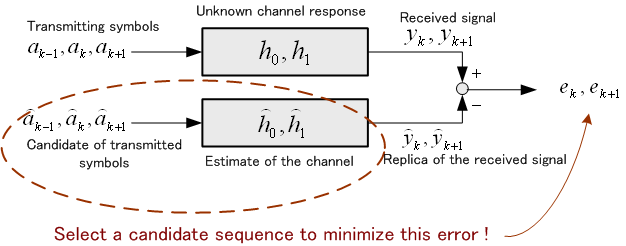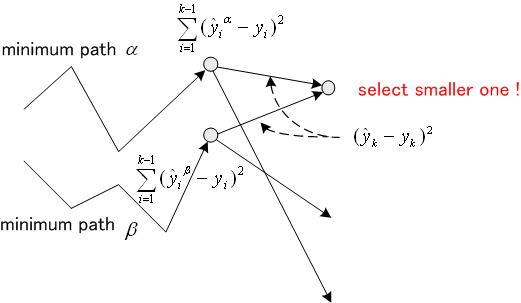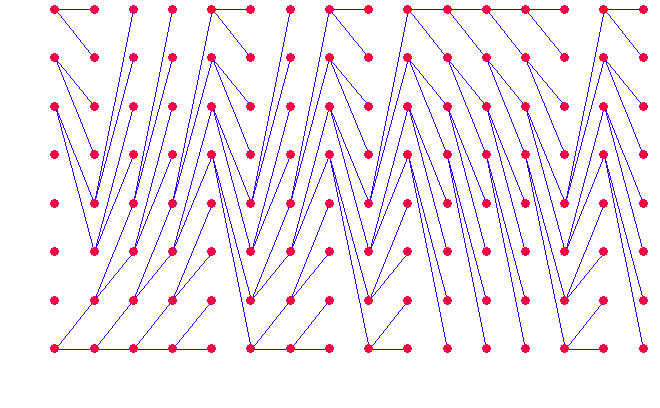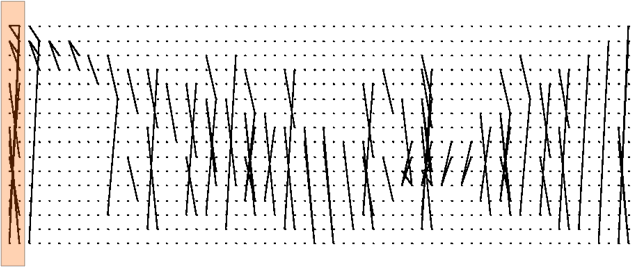
1. Non-blind estimation problems
Case1: Estimate the system (impulse response) when input sequence is known.




Recursive formula of Kalman filter,







gives exact minimum of the least squares error at time L, i.e.,

Note
that  tends to inverse of the correlation matrix as
tends to inverse of the correlation matrix as
 ,
,
and
the convergence is suddenly accelerated after  becomes full rank.
becomes full rank.
Case2: Estimate input sequence when impulse response is known.

Assume
that symbol  has
discrete values and its length is finite. Then the optimum detection
is given by chosing maximum of a posteriori probability.
i.e.,
has
discrete values and its length is finite. Then the optimum detection
is given by chosing maximum of a posteriori probability.
i.e.,
 ,
,
where
vector  denotes
candidate of the symbol sequence. Under AWGN, this detection
leads to MLSE (Maximum Likelihood Sequence Estimation).
i.e.,
denotes
candidate of the symbol sequence. Under AWGN, this detection
leads to MLSE (Maximum Likelihood Sequence Estimation).
i.e.,

In order to extend this finite MLSE to infinite one, let us apply the following optimality principle of the dynamic programming.

For
every sub-sequence  contained in replica
contained in replica  ,
select the minimum path (right hand side of above equation).
,
select the minimum path (right hand side of above equation).

In result, each node has single coming path. Therefore, we can trace back directly without losing the way. If all traces back from nodes merge at a node, the previous path reaching to this node should be true. See the trellis graph below.
2. Two approaches to blind estimation
Suppose the simplest model of binary transmission over two-ray multi-path channel. The replica is formed by

where
all variables  are unknown. First of all, we must define branch metric measuring distance
between replica and the received signal. It is trivial that a
squares error
are unknown. First of all, we must define branch metric measuring distance
between replica and the received signal. It is trivial that a
squares error  cannot be branch metric, because it has too large freedom. Therefore,
branch metric may be defined by using sequence of squares
error,
cannot be branch metric, because it has too large freedom. Therefore,
branch metric may be defined by using sequence of squares
error,

Note
that above set of squares errors contains L+1 unknown symbols
 and
the number of candidates is
and
the number of candidates is  . Let us
define two types of branch metric for branch
. Let us
define two types of branch metric for branch
 .
.
(1) First definition suggested from case1 (Blind Kalman)
For
each candidate  ,
find
,
find  which minimizes
which minimizes
 ,
,
and define the branch metric by

(2) Second definition suggested from case2 (Blind Viterbi)
For
each candidate  ,
define the branch metric by the minimum of
,
define the branch metric by the minimum of

Let us call the first and the second respectively explicit and implicit method. Both methods seem to give MLSE solution for large N. However, since we must treat rapidly faded channel, L should be chosen as small as possible.
3. Singular situations
Consider simple case of L=3. The trellis graph is drawn as below, where each node corresponds to symbol sequence; (-1,-1,-1) , (-1,-1,1) ,・・・.

(1)
In the explicit method, we must find a solution  of
of
 .
.
However, the solution is not unique or nothing when the matrix


is singular. In this case, we must borrow a past solution at non-singular branch along the path reaching this node. Risk of singularity can be reduced by increasing L.
(2) The implicit method needs not to find a solution. The squares error is written as


The
minimum of  is
calculated by
is
calculated by







As
long as  is non-singular (rank=3), minimum of
is non-singular (rank=3), minimum of  is
realized only at true solution of
is
realized only at true solution of  .
.
When
 is singular (rank<3), the least squares solution
is singular (rank<3), the least squares solution  cannot be unique. However, Moore-Penrose general inverse gives an unique
solution satisfying
cannot be unique. However, Moore-Penrose general inverse gives an unique
solution satisfying  with
with
 .
Therefore, unbiased estimation of
.
Therefore, unbiased estimation of  is not guaranteed and
is not guaranteed and  is
over-minimized beyond true minimum of MLSE.
is
over-minimized beyond true minimum of MLSE.
4. Algebraic structure of singularity
In case of noise free, consistency of the algorithm is stated in same sentence for both cases.
Take
set of L equations from long chain of equations as shown
below. At each stage, find surviving candidates  which satisfy the set of equations. Such survivor, if it is false, cannot
keep to survive in future. Consistency of the algorithm
requires that all false survivors (paths) go to dead end and a true one
remains forever.
which satisfy the set of equations. Such survivor, if it is false, cannot
keep to survive in future. Consistency of the algorithm
requires that all false survivors (paths) go to dead end and a true one
remains forever.



Above graph shows a case that true path remains, but we have still substantial question for the uniqueness of surviving path.
CONJECTURE
Let
length of impulse response be N. If sequence  keeps one-to-one correspondence to the transmitted signal
keeps one-to-one correspondence to the transmitted signal  , the
surviving path is uniquely determined for L>N except polarity
ambiguity.
, the
surviving path is uniquely determined for L>N except polarity
ambiguity.

For L=4 and N=3, let us classify the branch graphs. In this case, the length of candidate becomes 6 and the number of nodes must be 32. For simple graph drawing, let us reduce the number of node in half by removing polarity ambiguity. For example, assign both (1,1,-1,1,-1) and its opposite polarity (-1,-1,1,-1,1) to a node. Thus we have a bipartite graph with 32 possible transitions (branches).The surviving branch graphs are classified into three types by property of channel response as follows.
Type 1: When the one-to-one correspondence is satisfied, the number of surviving branch is small and true path remains uniquely. Graphs below show set of surviving branch graphs and one of them is remarked by orange colored box. There are 32 graphs which correspond to 32 of the transmitted sequence patterns (note; the polarity ambiguity was removed).
It is rather significant to analyze topological regularity in these graphs.


Type
2: This is a typical case that response  has a spectrum null. If the spectrum of periodic transmitted sequence
concentrates on this null point, all branches survive because
the received signal vanishes. While such periodic sequence
is not transmitted, all false paths go to dead end.
has a spectrum null. If the spectrum of periodic transmitted sequence
concentrates on this null point, all branches survive because
the received signal vanishes. While such periodic sequence
is not transmitted, all false paths go to dead end.


Type3:
Another singularity is caused by time shift
ambiguity such as  or
or  . In this cases,
large number of branches survive and paths will frequently
cross over.
. In this cases,
large number of branches survive and paths will frequently
cross over.


Above
blind sequence detection was based on assumption that the
channel can be regarded approximately as invariant in interval
L. The shortest model of L=N+1 is possible to track the
highest fade rate channel.
In actual noisy cases, all
branches (32 in above example) have non-zero metric. By taking
set of branches having small metric, we can estimate the type
of current channel response. It may be an interesting work to
develop the diversity or MIMO with checking the type of branch
graph.
-------------------------- References ----------------------------
Sato Y:"A Blind Sequence Detection and Its Application to Digital Mobile Communication" IEEE Journal on Selected Areas in Communications, Vol.13, No.1,pp49-58, January 1995
Cited by
Miguez, J; Djuric, PM. : "Blind equalization of frequency-selective channels by sequential importance sampling". (2004) IEEE TRANSACTIONS ON SIGNAL PROCESSING 52 (10), Pages 2738-2748, Part 1
Patwary M.N., Rapajic P., Shao X., Oppermann I.: "Adaptive Blind Sequence Detection for Time Varying Channel " (2003) Conference Record / IEEE Global Telecommunications Conference, 6, Pages 3376-3380.
Daneshgaran
F., Laddomada M. : "Iterative LBG clustering for SIMO channel
identification "
(2003) Journal of
Communications and Networks, 5 (2), Pages 157-166.
Daneshgaran F., Laddomada M. : "Multiscale iterative LBG clustering for SIMO channel identification " (2002) IEEE International Conference on Communications, 1, Pages 84-88.
Daneshgaran F., Mondin M., Dovis F., Roden M.S. : "Blind estimation of output labels of SIMO channels based on a novel clustering algorithm " (1998) IEEE Communications Letters, 2 (11), Pages 307-309.
Taylor
D.P., Vitetta G.M., Hart B.D., Mammela A. : "Wireless Channel
Equalisation "
(1998) European Transactions on
Telecommunications, 9 (2), Pages 117-143.
Reader D.J., Cowley W.G. : "Method for preventing delay ambiguity " (1997) Electronics Letters, 33 (4), Pages 263-265.